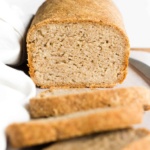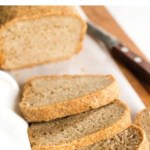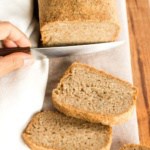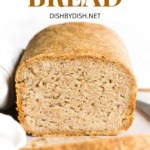Description
This hearty loaf of gluten-free whole grain bread is made with fiber-rich flours for an earthier flavor and taste. It’s perfect for toasting and spreading with jam for breakfast, or making sandwiches for lunch or dinner too. Totally dairy-free and vegan as well. Bake a loaf or two of this gluten-free brown bread to enjoy homemade bread today!
Ingredients
- 3/4 cup brown rice flour
- 3/4 cup sorghum flour
- 1/2 cup millet flour
- 2/3 cup potato starch
- 1/3 cup tapioca starch
- 1 teaspoon xanthan gum
- 1 teaspoon baking powder
- 1 1/2 teaspoons salt
- 2 tablespoons psyllium husk powder
- 2 1/4 teaspoons instant yeast
- 2 tablespoons sugar
- 1 1/2 cups warm water (between 105F to 115F)
- 1/3 cup sunflower oil
Instructions
- Grease Loaf Pan: Grease an 8″ x 4″ nonstick metal loaf pan.
- Whisk Dry Ingredients: In a large mixing bowl, combine the brown rice flour, sorghum flour, millet flour, potato starch, tapioca starch, xanthan gum, baking powder, salt, psyllium husk powder, instant yeast and sugar together. Whisk well to combine.
- Add Wet Ingredients to Form Dough: Add the warm water and vegetable oil to the large bowl with the dry ingredients and mix well to get a homogeneous wet and sticky dough.
- Transfer Dough to Loaf Pan: Transfer the gluten-free whole grain bread dough to the previously greased loaf pan and smooth out the top of the dough with a wet spatula.
- Let Dough Rise: Let the dough rise for 1 hour in a warm place free of drafts until it has roughly doubled in size, and has risen to almost the top of the pan.
- Preheat Oven: During the last 15 minutes of the rise, preheat the oven to 350F and arrange the oven rack to the middle position.
- Bake Until Golden: Bake the dough until it is golden and the loaf sounds hollow when tapped.
- Cool Completely Before Slicing: Allow the gluten-free whole grain loaf to cool completely at room temperature on a wire rack before slicing.
Notes
Brown Rice Flour: I like using brown rice flour as one of the base flours, I would not recommend that you swap this out.
Sorghum Flour: If you don’t have sorghum flour, you can also use quinoa flour as a substitute.
Millet Flour: If you don’t have millet flour, you may use amaranth flour, teff flour or buckwheat flour in replacement.
Potato Starch: Potato starch helps to bind the ingredients together. If you don’t have potato starch, you may use equal amounts of corn starch instead.
Tapioca Starch: Tapioca starch is also known as tapioca flour. If you don’t have tapioca starch, feel free to use arrowroot starch instead.
Xanthan Gum: Xanthan gum is the replacement for gluten in gluten-free flours and helps to bind the ingredients together. Make sure to include this in for best results.
Baking Powder: In addition to the yeast, baking powder helps to give the bread dough more rise.
Psyllium Husk Powder: Using psyllium husk powder gives the bread dough more binding power. Make sure you are using the powdered version. If you only have access to whole psyllium husks, you can grind the whole husks in a coffee grinder or high-speed blender until you get a smooth powder.
Instant Yeast: I like using instant yeast because no pre-activation period is required and you can mix it in with the other dry ingredients directly. If you only have active yeast, make sure to pre-activate the yeast (you can do this by mixing the yeast with the warm water and sugar in a small bowl and letting it sit in a warm area for 5 minutes until it turns foamy).
Sugar: The sugar is required a “food” for the yeast to feed on to produce the gases required to create the air bubbles in the dough for it to rise. I used white sugar, but you can also use light brown sugar, dark brown sugar or coconut sugar if you prefer.
Warm Water: Make sure that the water is between 105F to 115F because you need enough warmth for the yeast to be activated, but if the water is too hot, the high temperature will kill the yeast. You may also use an equal amount of warm unsweetened non-dairy milk (such as almond milk, cashew milk, rice milk, tigernut milk or soy milk). Alternatively, if you are not lactose-intolerant, you may also use normal dairy milk instead.
Oil: I like using sunflower oil because I always have a bottle on hand. You may also use melted vegan butter or another vegetable oil (such as olive oil, avocado oil or even melted coconut oil). Alternatively, if you are not lactose-intolerant, feel free to use melted butter or ghee if you prefer.
Storing/Freezing: To store, place the cooled loaf of gluten-free whole grain bread in an airtight container or wrap in plastic wrap and store in the refrigerator for up to 5 days. To freeze, place the cooled loaf in freezer-safe ziploc bags or wrap in various layers of plastic wrap and freeze for up to 2 months. To defrost, let the frozen loaf thaw overnight in the refrigerator before slicing and toasting.
- Prep Time: 15 mins
- Rising Time: 1 hour
- Cook Time: 1 hour
- Category: Bread
- Method: Baking
- Cuisine: Western



